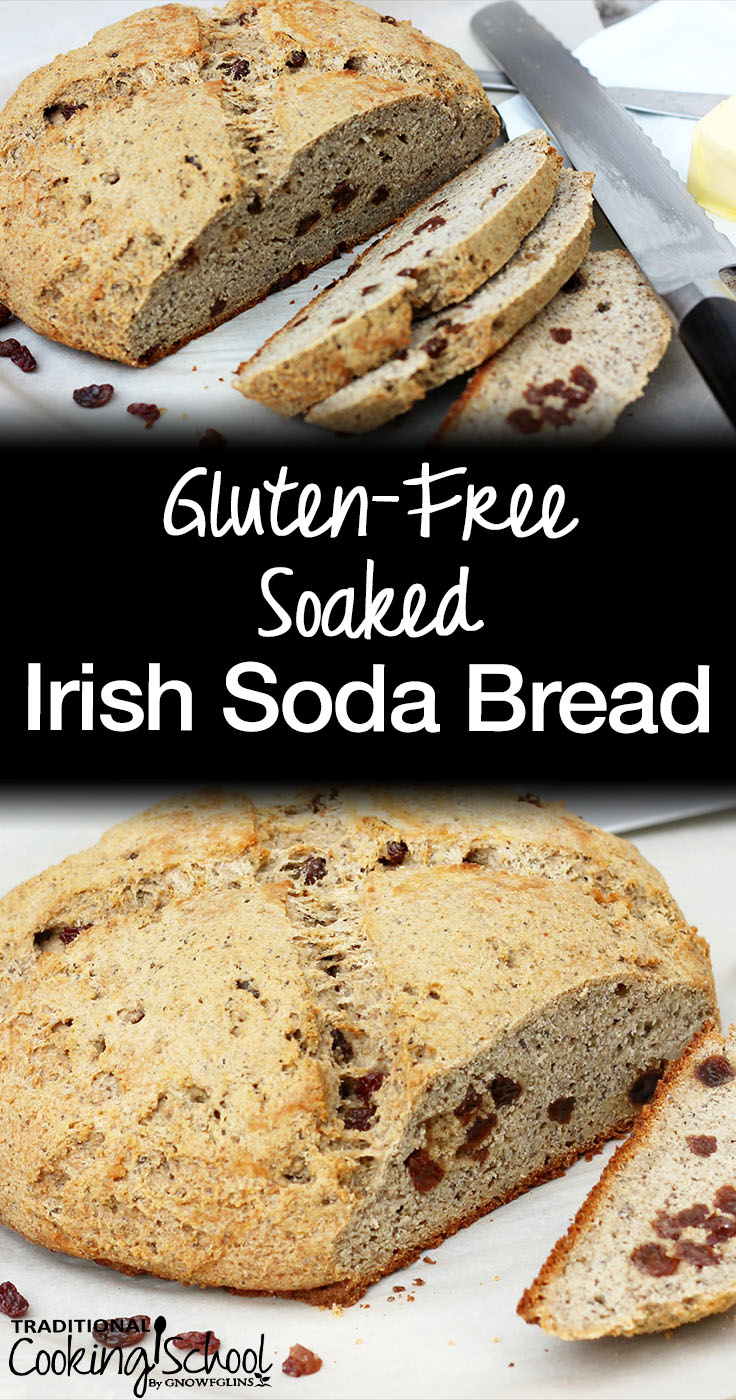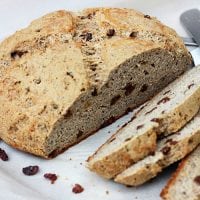
Whether you’re new to bread-baking or an old hand, this Gluten-Free Soaked Irish Soda Bread will appeal to you!
The results: delicious, exciting. The process: easy, fun!
Soda breads, by nature, are not difficult. When baking soda reacts with acidic buttermilk, the dough rises. There’s no yeast, no starter, and no kneading! I use simple hand beaters. Or, the paddle attachment to your upright mixer works well, too.
Despite its ease, this gluten-free bread yields impressive results — a beautiful “x” across its top which bursts open during baking, a golden crust, a hearty yet soft middle. Although optional, my family loves to add raisins. And why not cinnamon, too, for cinnamon-raisin toast?
The History Of Soda Bread
Soda breads originated in Ireland. Apparently, they were also common fare in Australia, Serbia, Scotland and the early Americas. Baking soda was first introduced to Ireland in the 1800s, when virtually no one there had ovens. The soda allowed them to make loaves of bread on their stove tops, in cast iron pots with the lids on!
Poor peasants with no ovens also had only meager staples: flour, buttermilk, salt and baking soda. Surprisingly, although created out of want, soda breads have remained popular. That’s because they’re reliable. They don’t require advanced bread baking skills or a lot of work. And the ingredients are usually on hand.
Plus, as you’ll see upon making this recipe, soda breads are delicious! They deliver a yeast-like bread that can be used for toast or sandwiches, for a healthy snack or side.
Staunch traditionalists stick by Irish soda bread’s original four ingredients: flour, buttermilk, salt and baking soda. They’re happy to eat versions like this one, studded with raisins and leavened with a bit of egg, but technically this recipe is then called a cake, specifically Spotted Dog or Railway Cake.
As you’ll see from other soda bread recipes, raisins, eggs, butter (and now gluten-free!) changes are part of the food evolution that occurs in our world. There are always regional variations on any original version.
Fun fact: the beautiful cross cut into the top of the loaf allows it to expand while baking. The quarters created by the cross are called farls.
About These Gluten-Free Ingredients
My version of Irish soda bread is gluten-free, which actually mimics — to an extent — original soda bread. Irish bakers used soft wheat, which contains less gluten than hard wheat flour.
Let’s go through a few of the ingredients in this gluten-free soda bread…
- Rice and sorghum flours — soaked overnight in an acidic medium for optimum digestibility (sour milk, buttermilk, clabbered milk, or kefir)
- Chia seed flour and psyllium husk flour — for elasticity
- Egg and water — for a lighter loaf and good rise
- Buttermilk — to soak the flours and make them more digestible by reducing phytate content
I love using the traditional buttermilk to “pre-digest” the flour. I can’t imagine not doing so — it’s already in the recipe!
By combining flour and buttermilk 12 to 24 hours in advance, we create a better loaf for gut and body. Without further ado, here’s my gluten-free and soaked version of Irish soda bread, combining traditional preparation methods with a traditional loaf for the best of both worlds.

Gluten-Free Soaked Irish Soda Bread
Soda breads are reliable, easy, and require only simple ingredients that most people keep on-hand. No yeast, no starter, no kneading... This Gluten-Free Soaked Irish Soda Bread combines traditional preparation methods with a traditional loaf for the healthiest loaf for gut and body!
Ingredients
- 1-1/2 cups acidic medium of choice buttermilk, sour milk, clabbered milk, or kefir
- 1/2 cup pure water
- 2 cups brown rice flour
- 1 cup sweet white sorghum flour
- 1/3 cup chia seed flour grind 2/3 cup chia seeds, then measure flour
- 1/4 cup psyllium husk powder NOT husks, must be the husk *powder
- 2 tablespoons coconut sugar
- 1 teaspoon baking soda
- 1/2 teaspoon sea salt
- 1/2 cup grass-fed butter melted and cooled
- 1 organic or pastured egg
- 2/3 cup raisins optional
Instructions
-
Add buttermilk, water, brown rice flour, and sorghum flour to a large mixing bowl.
-
Using hand beaters on low speed, combine ingredients well.
-
Form batter into a ball and place in ceramic dish. Cover and leave at warm room temperature for 12 to 24 hours, or overnight.
-
Once dough is soured, preheat oven to 375 degrees Fahrenheit.
-
Grease cookie sheet or line with parchment paper. Set aside.
-
Transfer dough ball to a large mixing bowl.
-
In separate medium size bowl, combine remaining dry ingredients: chia seed flour, psyllium husk powder, coconut sugar, baking soda, and sea salt.
-
Add cooled melted butter, egg, and dry ingredients to the soured dough.
-
Use hand beaters on medium-low speed to combine all ingredients well, about 30 seconds. Do not over-mix.
-
Add raisins, if using, and mix again to combine.
-
Dough will be soft at this point, but will continue to stiffen quickly.
-
Form dough into desired boule shape, place on prepared cookie sheet, and continue to pat it into desired shape.
-
Use a sharp knife to make an “x” across the surface of the loaf, about 1/2-inch deep.
-
Place into preheated oven and bake for about 55 minutes, until it feels somewhat light and sounds hollow when tapped on the bottom. (This loaf will not sound as light as some loaf recipes — it’s a bit heavier by nature.)
-
Slice and enjoy!
Recipe Notes
- Click here for psyllium husk flour
What about you? With raisins or without? 😉
We only recommend products and services we wholeheartedly endorse. This post may contain special links through which we earn a small commission if you make a purchase (though your price is the same).


hi Megan,
I’m curious if I can use my brown rice flour Sourdough Starter (resting in the fridge the past few days) in place of any of the water and rice flour here? It was very bubbly and alive prior to my letting it rest…takes us at least a week to go through a loaf of bread, sometimes longer!
Otherwise I will Sour per this recipe . Looks yummy!
Thanks!
Hi Judy,
I think in this case it is best to go by the recipe exactly. I LOVE using a brown rice sourdough starter for baking, but because this recipe is soaked it would be hard for me to direct you on ratios without baking a few loaves myself. Best wishes and enjoy!
P.S. Did you mean to give the recipe 3 stars? It’s okay if you did, but I just want to be sure as I think it might have been a mistake! 🙂 🙂
Hi Megan,
Thank you , I will use your recipe! ….I wasn’t sure if I should Star at all as I hadn’t baked it yet so I gave 3 for looking so tempting! I didn’t mean to slight it by the 3 stars, oops! I’ll be making your bread on the weekend and give you feedback for sure!! I’m excited!
Judy, no problem!! 🙂 I hope you enjoy the baking process and outcome. It really is a fun loaf to make and eat. 🙂
Can I use Ghee instead of butter or wiil that make a major change?
how about coconut oil instad of butter? I am VERY dairy initollerant.
Thanks- Love this site of yours! Tina
Hi Tina, both of those subs will work fine. Either one, shouldn’t be a problem. 🙂
This recipe looks so good! I’m wondering if I can use whole psyllium husk and grind them into powder in my vitamix? Do you know if that would work? Thanks!
Hi Amy, I don’t know if that would yield the same results and don’t recommend it. I would go with the husk powder.
Is there a dairy free soaking medium you would recommend?
Hi Stephanie, yes, actually. There is a way to do this recipe without dairy. You can use 1/2 cup sauerkraut juice (not one with strong flavors like garlic 😉 ). And then the rest of that initial (buttermilk) liquid, (which would be 1 cup) can be a non-dairy milk of choice. So instead of 1-1/2 cups buttermilk, use 1/2 cup sauerkraut juice and 1 cup non-dairy milk. I haven’t done this with this recipe, but I have done many similar exchanges with soaked breads, so it should work well.
Hi Megan,
I don’t have a non-strong sauerkraut at the moment (kimchi actually :)). Could I just use the usual way to make soured milk with my non-dairy milk and lemon juice?
Hi Christine, you can only use sour milk in this role if it’s raw milk (so no lemon juice needed). The food source used needs to have living probiotics. 🙂
My sauerkraut doesn’t have that much excess juice. Do you think water kefir or kombucha would work?
Good afternoon, Megan.
Question about the soaked Irish soda bread: This is my first time baking with soaked flours. I’m not a baker so I am really outside my knowledge area.
I followed the recipe instructions exactly. The description said to form the batter into a ball and put in a ceramic dish to sour overnight. My batter was a very thick pourable batter – kind of like cake batter. There was no way it was forming a ball. I put it in a large glass bowl so it’s kind of in a ball. 🙂
Do I need to adjust the recipe tomorrow when I bake the bread?
Thanks much,
Beth
Hi Beth, the batter should have been thicker than what you describe. Did you end up baking it? What happened? I wish I could help you trouble-shoot more, but it’s hard to know quite what happened.
Hi Megan
I just am starting to make this sofa bread and my mixture is as Beth’s and is more like cake batter. I followed directions as Beth did exactly; I was going to add more rice flour but decided to just leave it and see what happens in morning.
Shirley, I’m experiencing the same. What did you do and did it work out?
Is there a flour I could substitute for the rice flour?
Hi Lindsay, I haven’t made the recipe subbing out the rice flour so I can’t say for sure. You could certainly sub it with 1-3 other flours, as each have their own properties when baked and flavors. If you have a gluten-free blend you like, that may work fine.
Hi Megan,
I’m searching for a bread recipe that’s… get ready for it… coconut, dairy, egg, and gluten free. I’m using goat milk and the gluten part is taken care of but I’m not sure how to substitute the egg and butter. I don’t have access to goat butter. Suggestions?
Thanks!
Carissa
Palm shortening for butter.
1 T. ground flax seeds mixed in 3T. water equal 1 egg. I use this one a lot.
You can also use chia seeds but I have not tried that one.
Google egg replacement and you will find quite a few.
I cannot thank you enough for this recipe. I’ve tried so many recipes, and this is the easiest and tastiest gluten free, wholesome bread I’ve ever tried. It has great rise, texture, and it’s totally easily sliceable. I’ve made it twice already and even the teenagers like it. For those that have the psyllium husks instead of the powder, I will confess that I used the husks–I blended them in my bledtec (high speed blender) with the chia seeds, and it worked great! Also, my batter seemed wetter than it should be, but it turned out perfect!! Again, thank you!!
Thank you so much for your feedback, and I’m so happy the recipe is a good fit your family! Blessings! 🙂
Hi, I also had the problem of the batter being too thin. It seemed like 2 cups of rice flour and 1 cup of sorghum just isn’t enough to make it thick. Could there be a typo? I wonder if you could provide weight instead of volume measurements if that’s not the issue? Or maybe I should just keep adding more flour until it’s thick enough?
Hi Cheryl, I’m sorry for your trouble. There isn’t a typo, so I don’t know what could be the issue. You can certainly add a little more flour, chia meal or psyllium husk powder, as long as you don’t add to much.
Cheryl, I’m experiencing the same. What did you do, and did it work out?
I love this recipe and come back to it every year for a wholesome, festive treat for St. Patrick’s Day.
I have been making this bread weekly for years now. I recently switched to making it in loaf pans, and it comes out just fine! I just spray my loaf pans with a little coconut oil spray. It’s delicious and I make it exactly like the recipe. Family members that have gut issues can eat this bread comfortably.
Hi Megan! Still making this bread and have shared it countless times. I have a question… I would like to switch from using raw milk to using homemade yogurt as the culture. Do you think k that’s ok and what would the proportions be? Thx so much!
I’m having the same issue as others. The buttermilk, water, and flours, per the recipe, blend to a very thin batter. I’m not sure what to do at this point. Add more flour tonight? Wait until morning?